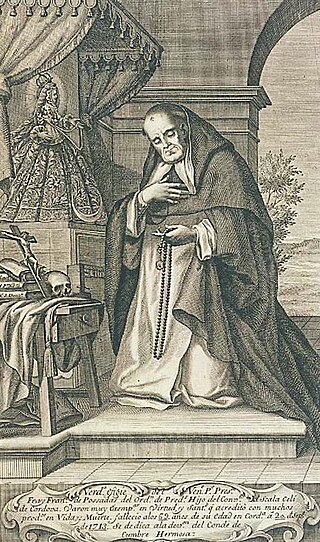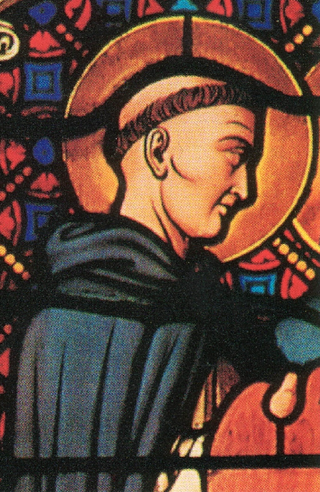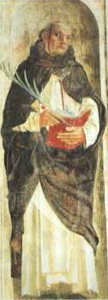Giovanni Giovenale Ancina was an Italian Roman Catholic prelate who served as the Bishop of Saluzzo and was a professed member from the Oratorians. The bishop was also a scholar and music composer and was also known for being a noted orator. He served in the Oratorians as a simple priest for around two decades prior to his episcopal appointment which he attempted to elude for five months before submitting to Pope Clement VIII and accepting the papal appointment. He entered his diocese several months later where he became noted for his charitable work with the poor and his efforts to better implement the reforms of the Council of Trent.

Giuseppe Girotti, OP was an Italian Dominican priest who was a biblical scholar and a professor of theology. During World War II, he worked to aid Jewish people amid the Nazi Holocaust. Girotti was arrested in 1944 and moved from prison to prison before being imprisoned at the Dachau concentration camp, where he befriended Josef Beran and Carlo Manziana.

Pio Alberto del Corona - born Alberto del Corona and in religious Pio - was a Roman Catholic Italian prelate and the founder of the Suore Domenicane dello Spirito Santo. He served as the Bishop of San Miniato from 1897 until his resignation one decade later. The bishop served as a humble pastor though reluctant as he was to accept his episcopal appointment while even protesting against an idea to elevate him into the cardinalate. He exercised his duties until ill health forced him to resign from his see though was given a ceremonial position since Pope Pius X did not wish to relieve him of all his episcopal duties and functions.

Leopoldo da Gaiche, born Giovanni Croci, was an Italian Roman Catholic priest and a professed member of the Order of Friars Minor who became well known for wearing a crown of thorns. He was a preacher who went from diocese to diocese and served in a position of power in the Franciscan order in the Umbrian region in which he pushed for strong adherence to the Rule of Saint Francis of Assisi. He has been called the "Apostle of Umbria".
Marcantonio Durando was an Italian Roman Catholic priest and a professed member of the Congregation of the Mission in an effort to follow the teachings of Vincent de Paul - an ardent focus of his life and pastoral career. Durano was also the founder of the Daughters of the Passion of Jesus the Nazorean (1865) - or Nazarene Sisters - and founded that order with the assistance of Luigia Borgiotti (1802-1873).

Baldassare Ravaschieri was an Italian Roman Catholic priest and a professed member of the Order of Friars Minor of the strict observance. Ravaschieri served as a noted preacher and confessor and befriended as contemporaries Blessed Bernardine of Feltre and architect Giovanni Antonio Amadeo.

Andrea Franchi was an Italian Roman Catholic member of the Order of Preachers who served as the Bishop of Pistoia before his resignation due to ill health. Franchi became a noted preacher and evangelist who was also known for his holiness and his deep commitment to the poor of his diocese.

Domenico Spadafora was an Italian Roman Catholic priest and a professed member of the Order of Preachers. Spadafora was a noted evangelist and attracted countless to the Dominican fold while also converting the hearts of others who led dissolute lives. He is best known for being the first superior of a church he oversaw construction of in Monte Cerignone after receiving the papal approval of Pope Alexander VI to commence such work.

Luca Antonio Falcone – in religious life Angelo – was an Italian Roman Catholic priest and a professed member of the Franciscan Order of Friars Minor Capuchin in Cosenza. Falcone had a rough call to religious life after several entries and exits into the order and he later served as a noted preacher across southern Italian cities such as Catanzaro and Salerno after his first few sermons attracted little following. He became titled as both the "Angel of Peace" and the "Apostle of the South".

Antonio Patrizi was an Italian Roman Catholic priest and a professed member of the Order of Saint Augustine. Patrizi joined the order in Lecceto and lived as a hermit prior to his sudden death while visiting his friend at another convent.

Francisco Martín Fernández de Posadas was a Spanish Roman Catholic priest and a professed member of the Order of Preachers. He became a noted preacher and popular confessor while being hailed as a second Vincent Ferrer and in the beginning was subjected to violent dislike and ridicule from fellow Dominicans before he was allowed to enter the order.
Giacomo Benefatti was an Italian Catholic priest and professed member of the Order of Preachers who ascended to the position of Bishop of Mantua. Benefatti became noted for his tender care of the ill during epidemics of plague and both Pope Benedict XI - a close personal friend - and Pope John XXII held him in high esteem.

Bartolomeo Cerveri, OP was an Italian Catholic priest in the Order of Preachers. He served as an inquisitor for Piedmont and Liguria and knew of threats against his life; a small group of heretics killed him in Cuneo. He was beatified by Pope Pius IX in 1853.

Guala de Roniis was an Italian catholic priest and a professed member of the Order of Preachers as one of Dominic of Osma's earliest disciples. De Roniis was born as a noble and was appointed as the Bishop of Brescia after Dominic's death though also served as a popular papal legate that earned him popular and papal support. He resigned from his episcopal see to dedicate the remainder of his life to peaceful solitude though his reputation for personal holiness prompted countless people to seek him out for his counsel.

Giacomo Bianconi was an Italian Roman Catholic priest and a professed member of the Order of Preachers. Bianconi - who hailed from Umbria - joined the order in his adolescence and dedicated his pastoral career to his flock and on one notable occasion aided refugees when Frederick II sacked the area in 1248. He also combatted heresies and managed to convert one of their chief propagators while also distinguishing himself through his life of extreme poorness that went past the Dominican standards.

Marianna Fontanella, OCD, also known as Maria degli Angeli or Mary of the Angels, was an Italian Catholic member of the Discalced Carmelites. Fontanella studied with the Cistercians as a child and entered the Discalced Carmelites despite the protests of her mother and siblings. She soon became a noted abbess and prioress and in 1703 inaugurated a new convent of which she herself oversaw the establishment.
Bonaventura Tornielli was an Italian Roman Catholic priest and a professed friar from the Servite Order. Tornielli was born into a noble household and was a noted preacher in which he visited numerous Italian cities such as Florence and Perugia - Pope Sixtus IV held him in high esteem and even named him the "Apostolic Preacher". He also held various positions of leadership within his order.

Pietro Geremia was an Italian Roman Catholic priest and a professed member from the Order of Preachers. Geremia was born in Palermo but spent an extended period of time in Bologna – where he experienced a radical conversion – and Fiesole for his admittance into the Dominicans before returning to Palermo where he became a sought after and noted preacher and miracle worker.

Aimone Taparelli was an Italian Roman Catholic priest and a professed member from the Order of Preachers. He served as an Inquisitor-General for his order in the Lombard and Liguria regions and became a travelling preacher in northern Italian cities.

André Abellon, O.P. was a French Roman Catholic priest and a professed member from the Order of Preachers. He became a Dominican after hearing the preaching of Vincent Ferrer and studied art before joining their ranks. Abellon gained fame as a noted preacher and confessor but became a prominent figure after tending to victims of the plague in Aix-en-Provence in 1445. He was also a noted artist and painter with some of his works still surviving at present.















